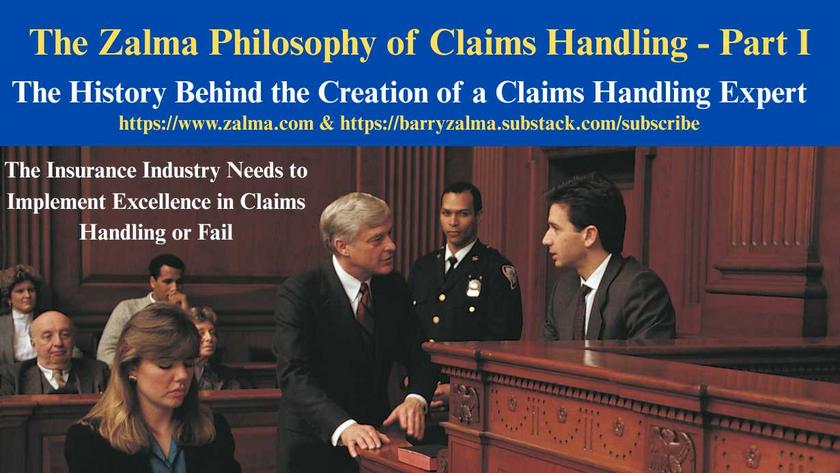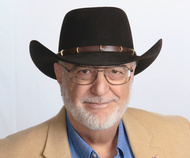
Circumstances that Could Result in Loss Must be Reported to Insurer
Barry Zalma
Feb 26, 2024
Transcript
This is Barry Zalma speaking for Claims School Incorporated's blog Zalma on Insurance.
Today we're going to explain why an exclusion for failure to advise an insurer of a known potential loss of circumstances that could result in loss will make it difficult if not impossible for the insured to obtain a
Defense or Indemnity from the Insurer.
The Supreme Court, New York County, Barry R. Ostrager J. entered a judgment which denied the plaintiff's motion for partial summary judgment as to liability for breach of contract
and sought product recall insurance coverage under a set of policies issued to the plaintiffs for the period of March 7, 2018 to 2019.
The order also granted defendants motions for summary judgment in part to the extent of dismissing the plaintiff's second cause of action,
Seeking Liability for Breach of Contract and for Coverage under a Set of Policies Issued to the Plaintiff for the Period March 7, 2019 to March 7, 2020.
In a case called Veyer Holding Company v. Westchester Surplus Lines, the New York Supreme Court on February 15, 2024 affirmed the trial court's decision.
Defendants issued a consumer goods insurance policy on medical devices sold by the plaintiffs.
The year one policy ended on March 7, 2019, at which point the year two policy began.
Each policy was triggered by an insured event discovered in the policy period, provided that Veyer gave written notice as soon as possible, no later than 30 days after discovery of the event.
Additionally, the policies excluded coverage for pre-existing circumstances the VAIR knew or should have known of prior to the inception of the policy that caused or could reasonably have been expected to cause an insured event.
The insured event was defined as a stock recovery, market withdrawal, or recall of an insured product
that could and would cause bodily injury or property damage stock recovery was defined by the policies but market withdrawal and recall were not
The product Enflow, a product insured under the policy, was first approved in 2006.
By 2018, it was used in many different countries.
Prior to March of 2019, there were no reports of patient injury due to aluminum toxicity.
In February 2018, however, Veyer learned of a then unpublished study indicating that Enflo may cause aluminum toxicity when used with a certain infusion.
On February 6, 2019, Veyer learned that the infusion did not contain malate, rather it contained lactate, which was commonly used in medical solutions.
In early March of 2019, Veyer learned that many hospitals in the United Kingdom had ceased using Enflo, and two EU regulatory agencies expressed their intentions to take regulatory action.
As a result, on March 5, 2019, Veyer decided to suspend Enflo use in the EU.
On March 7, 2019, Veyer began to file the paperwork for withdrawal with the FDA.
On March
11, 2019, Veyer's testing revealed unacceptable levels of aluminum leaching with many different infusions and on March 12, 2019, Veyer notified the defendants that they were about to issue a worldwide recall of Enflo and gave notice as to all representative policies and on March 13, 2019,
Mayer issued a global recall notification.
The Supreme Court, New York's trial court, properly determined, according to the appellate division, that coverage for year two was excluded under the prior notice exclusion.
The record established that by March 7 of 2019, Veyer knew or should have known about circumstances that could reasonably have been expected to cause an insured event.
The Supreme Court therefore correctly denied both motions for summary judgment as to the year one policy.
To establish that it satisfied the notification requirement, however, Veyer would have to prove that it discovered the event no earlier than February 10, 2019 and gave notice as soon as possible, before March of 2019.
There were no reported injuries due to aluminum toxicity from Enflo despite its frequent and widespread use.
Moreover, no regulatory agency had yet indicated any intention to recall the product, yet
By that date, Vyair had engaged in extensive communications with foreign regulatory agencies for approximately a year regarding Enflo's possible aluminum toxicity.
Vyair had also conducted its own testing regarding aluminum leaching.
Fyare knew that an infusion containing lactate not malayed leached potentially dangerous amounts of aluminum.
The competing claims, therefore, raise issues of fact as to whether Fyare had a reasonable belief until at least February 10, 2019 that no insured event had occurred.
If not, the coverage would not apply for either policy year.
In my opinion, this case teaches that every insurer of a liability insurance policy, including a products recall policy, should always advise the insurers when it learns of a potential of a loss that would be an insurable event under the policy.
VIAIR failed when it knew there was a potential product with the product and the danger of injury to people using the product.
Bayer failed on one policy year and potentially failed on the earlier year which the court left for the trial court to determine whether Bayer had a reasonable belief until February 10 of 2019 that no insured event had occurred.
The problem and litigation could have been easily resolved
By a Prop Notice of the Indications from the Foreign Regulatory Agencies.
This video was adapted from my blog Zalma on Insurance which is available free to anyone who clicks on the link zalma.com slash blog.
You can subscribe to the blog and you'll be
Give a Notice of Every Blog Posting, usually five or six a week, and you can also gain access to the more than 4,700 blog postings.
Please tell your friends and colleagues about the blog and the videos and let them subscribe to the blog and the videos as well.
They're free.
And if you're more interested in further detail about insurance, insurance law, insurance fraud, and insurance claims, please consider for a very small fee subscribing to my Substack publication.
Thank you for your attention.
Read the full policy at https://lnkd.in/g_4w-RtV, see the full video at https://lnkd.in/gcxMcBxQ and at https://lnkd.in/g4wDuRCv and at https://zalma.com/blog and more than 4700 posts.
The Supreme Court, New York County (Barry R. Ostrager, J.), entered a judgment which denied plaintiffs’ motion for partial summary judgment as to liability for breach of contract and sought product recall insurance coverage under a set of policies issued to plaintiffs for the period of March 7, 2018 to March 7, 2019.
The order also granted defendants’ motions for summary judgment in part, to the extent of dismissing plaintiffs’ second cause of action seeking liability for breach of contract and for coverage under a set of policies issued to plaintiffs for the period of March 7, 2019 to March 7, 2020.
In Vyaire Holding Company et al. v. Westchester Surplus Lines Insurance Company, et al, North American Capacity Insurance Company, 2024 NY Slip Op 00825, Appeal No. 1595, Index No. 652428/20, No. 2022-05619, Supreme Court of New York, First Department (February 15, 2024) the appellate division affirmed the trial court.
FACTS & PRIOR NOTICE EXCLUSION
Defendants issued consumer goods insurance policies on medical devices sold by plaintiffs (collectively, Vyaire). The Year One policy ended on March 7, 2019, at which point the Year Two policy began. Each policy was triggered by an “insured event” discovered in the policy period, provided that Vyaire gave written notice as soon as possible, no later than 30 days after discovery of the event. Additionally, the policies excluded coverage for pre-existing circumstances that Vyaire “knew of or should have known of, prior to the inception of this policy, that caused or could reasonably have been expected to cause… an ‘insured event’.”
The “Insured event” was defined as a” ‘stock recovery,’ market withdrawal or recall” of an insured product that would cause bodily injury or property damage. “Stock recovery” was defined by the policies but “market withdrawal” and “recall” were not.
THE PRODUCT
enFlow, a product insured under the policy, was first approved in 2006. By 2018, it was used in many different countries. Prior to March 2019, there were no reports of patient injury due to aluminum toxicity. In February 2018, however, Vyaire learned of a (then-unpublished) study indicating that enFlow may cause aluminum toxicity when used with a certain infusion. On February 6, 2019, Vyaire learned that the infusion did not contain malate. Rather, it contained lactate, which was commonly used in medical solutions.
In early March 2019, Vyaire learned that many hospitals in the United Kingdom had ceased using enFlow, and two EU regulatory agencies expressed their intentions to take regulatory action. As a result, on March 5, 2019, Vyaire decided to suspend enFlow use in the EU. On March 7, 2019, Vyaire began to file the paperwork for a withdrawal with the FDA. On March 11, 2019, Vyaire’s testing revealed unacceptable levels of aluminum leaching with many different infusions. On March 12, 2019, Vyaire notified defendants that they were about to issue a world-wide recall of enFlow and gave notice as to “all responsive policies.” On March 13, 2019, Vyaire issued a global recall notification.
ANALYSIS
The Supreme Court (trial court) properly determined that coverage for Year Two was excluded under the prior notice exclusion. The record established that by March 7, 2019 Vyaire knew or should have known about circumstances that could reasonably have been expected to cause an insured event.
The Supreme Court, therefore, correctly denied both motions for summary judgment as to the Year One policy.
To establish that it satisfied the notification requirement, however, Vyaire would have to prove that it discovered the event no earlier than February 10, 2019, and gave notice as soon as possible. Before March 2019, there were no reported injuries due to aluminum toxicity from enFlow, despite its frequent and widespread use. Moreover, no regulatory agency had yet indicated any intention to recall the product.
Yet, by that date, Vyaire had engaged in extensive communications with foreign regulatory agencies for approximately a year regarding enFlow’s possible aluminum toxicity.
Vyaire had also conducted its own testing regarding aluminum leaching. Vyaire knew that an infusion containing lactate, not malate, leached potentially dangerous amounts of aluminum.
The competing claims raise issues of fact as to whether Vyaire had a reasonable belief, until at least February 10, 2019, that no insured event had occurred.
ZALMA OPINION
This case teaches that every insured of a liability insurance policy should always advise the insurers when it learns of a potential of a loss that would be an insurable event under the policy. Vyaire failed when it knew there was a potential problem with the product and the danger of injury to people using the product. Vyaire failed on one policy year and potentially failed on the earlier year which the court left for trial to determine whether Vyaire had a reasonable belief until 2/10/19 that no insured event had occurred. The problem and litigation could have been resolved by a prompt notice.
(c) 2024 Barry Zalma & ClaimSchool, Inc.
Please tell your friends and colleagues about this blog and the videos and let them subscribe to the blog and the videos.
Subscribe to my substack at https://barryzalma.substack.com/publish/post/107007808
Go to Newsbreak.com https://www.newsbreak.com/@c/1653419?s=01
Go to X @bzalma; Go to the podcast Zalma On Insurance at; Go to Barry Zalma videos at Rumble.com at https://rumble.com/c/c-262921; Go to Barry Zalma on YouTube- https://www.youtube.com/channel/UCysiZklEtxZsSF9DfC0Expg.
Go to the Insurance Claims Library – http://zalma.com/blog/insurance-claims-library.
Please tell your friends and colleagues about this blog and the videos and let them subscribe to the blog and the videos.
Go to X @bzalma; Go to Newsbreak.com https://lnkd.in/g8azKc34; Subscribe to my substack at https://lnkd.in/gcZKhG6g
Go to the Insurance Claims Library – https://lnkd.in/gwEYkxD.
Subscribe to my substack at https://lnkd.in/gcZKhG6g
Detail Charging Defendant for Fraud is Sufficient
Post 5242
Read the full article at https://lnkd.in/g_HVw36q, see the video at https://lnkd.in/gpBd-XTg and at https://lnkd.in/gzCnBjgQ and at https://zalma.com/blog plus more than 5200 posts.
Charges that Advises the Defendant of the Crime Cannot be Set Aside
In United States Of America v. Lourdes Navarro, AKA Lulu, No. 25-661, United States Court of Appeals, Ninth Circuit (December 4, 2025) Lourdes Navarro appealed the district court’s denial of her motion to dismiss the indictment and enter final judgment was in error.
FACTUAL BACKGROUND
The indictment alleged that insurers reimburse only for medically necessary services. Navarro performed unnecessary respiratory pathogen panel (RPP) tests on nasal swabs collected from asymptomatic individuals for COVID-19 screening.
Navarro billed over $455 million to insurers for those additional RPP tests that she knew to be medically unnecessary. These allegations constituted a plain, concise, and definite written ...
Louisiana Statute Prevents Enforcement of Contract Term Requiring Arbitration of Disputes
Post 5241
Read the full article at https://www.linkedin.com/pulse/international-convention-requiring-enforcement-award-barry-sttdc, see the video at and at and at https://zalma.com/blog plus more than 5200 posts.
In Town of Vinton v. Indian Harbor Insurance Company, Nos. 24-30035, 24-30748, 24-30749, 24-30750, 24-30751, 24-30756, 24-30757, United States Court of Appeals, Fifth Circuit (December 8, 2025) municipal entities including the Town of Vinton, et al sued domestic insurers after dismissing foreign insurers with prejudice. The insurers sought arbitration under the Convention on the Recognition and Enforcement of Foreign Arbitral Awards (the “Convention”) but the court held Louisiana law — prohibiting arbitration clauses in such policies—controls, as the Convention does not apply absent foreign parties who ...
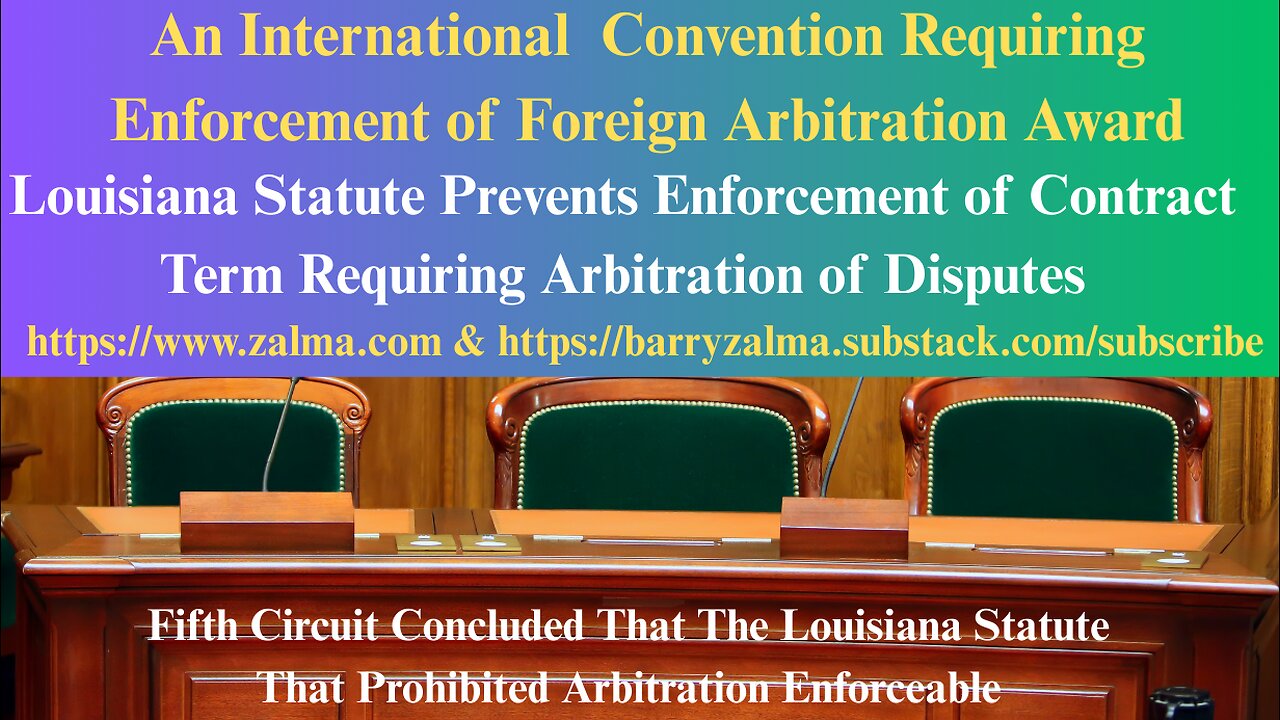
Refusal to Provide Workers’ Compensation is Expensive
Post 5240
Read the full article at https://lnkd.in/guC9dnqA, see the video at https://lnkd.in/gVxz-qmk and at https://lnkd.in/gUTAnCZw, and at https://zalma.com/blog plus more than 5200 posts.
In Illinois Department of Insurance, Insurance Compliance Department v.USA Water And Fire Restoration, Inc., And Nicholas Pacella, Individually And As Officer, Nos. 23WC021808, 18INC00228, No. 25IWCC0467, the Illinois Department of Insurance (Petitioner) initiated an investigation after the Injured Workers’ Benefit Fund (IWBF) was added to a pending workers’ compensation claim. The claim alleged a work-related injury during employment with the Respondents who failed to maintain workers’ compensation Insurance.
Company Overview:
USA Water & Fire Restoration, Inc. was incorporated on January 17, 2014, and dissolved on June 14, 2019, for failure to file annual reports and pay franchise taxes. It then operated under assumed names including USA Board Up & Glass Co. and USA Plumbing and Sewer. The business ...
The Professional Claims Handler
Post 5219
Posted on October 31, 2025 by Barry Zalma
An Insurance claims professionals should be a person who:
Can read and understand the insurance policies issued by the insurer.
Understands the promises made by the policy.
Understand their obligation, as an insurer’s claims staff, to fulfill the promises made.
Are competent investigators.
Have empathy and recognize the difference between empathy and sympathy.
Understand medicine relating to traumatic injuries and are sufficiently versed in tort law to deal with lawyers as equals.
Understand how to repair damage to real and personal property and the value of the repairs or the property.
Understand how to negotiate a fair and reasonable settlement with the insured that is fair and reasonable to both the insured and the insurer.
How to Create Claims Professionals
To avoid fraudulent claims, claims of breach of contract, bad faith, punitive damages, unresolved losses, and to make a profit, insurers ...
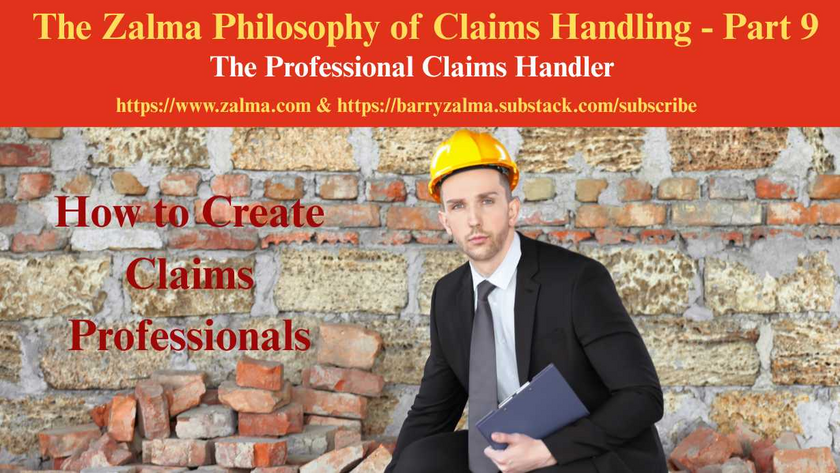
The History Behind the Creation of a Claims Handling Expert
The Insurance Industry Needs to Implement Excellence in Claims Handling or Fail
Post 5210
This is a change from my normal blog postings. It is my attempt. in more than one post, to explain the need for professional claims representatives who comply with the basic custom and practice of the insurance industry. This statement of my philosophy on claims handling starts with my history as a claims adjuster, insurance defense and coverage lawyer and insurance claims handling expert.
My Training to be an Insurance Claims Adjuster
When I was discharged from the US Army in 1967 I was hired as an insurance adjuster trainee by a professional and well respected insurance company. The insurer took a chance on me because I had been an Army Intelligence Investigator for my three years in the military and could use that training and experience to be a basis to become a professional insurance adjuster.
I was initially sat at a desk reading a text-book on insurance ...
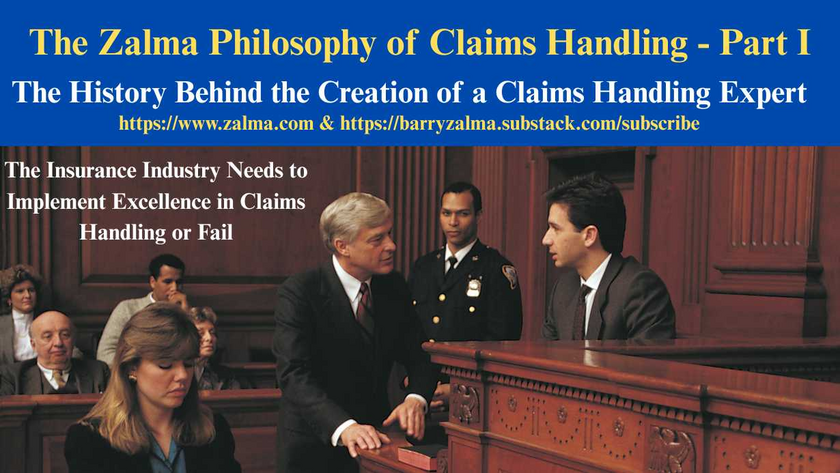
The History Behind the Creation of a Claims Handling Expert
The Insurance Industry Needs to Implement Excellence in Claims Handling or Fail
Post 5210
This is a change from my normal blog postings. It is my attempt. in more than one post, to explain the need for professional claims representatives who comply with the basic custom and practice of the insurance industry. This statement of my philosophy on claims handling starts with my history as a claims adjuster, insurance defense and coverage lawyer and insurance claims handling expert.
My Training to be an Insurance Claims Adjuster
When I was discharged from the US Army in 1967 I was hired as an insurance adjuster trainee by a professional and well respected insurance company. The insurer took a chance on me because I had been an Army Intelligence Investigator for my three years in the military and could use that training and experience to be a basis to become a professional insurance adjuster.
I was initially sat at a desk reading a text-book on insurance ...
